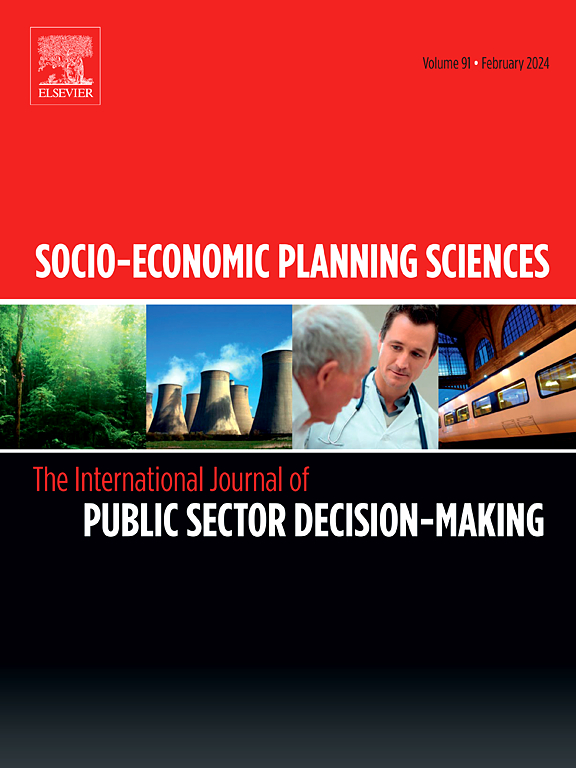The economic impact of terrorism in South Asia
IF 6.2
2区 经济学
Q1 ECONOMICS
引用次数: 0
Abstract
This study examines the economic impact of terrorism in South Asia. The region is currently home to 123 active terrorist/insurgent groups and is accountable for over 27 % of recorded global terrorist attacks. The annual data from the six most-terror-affected South Asian countries (Afghanistan, Bangladesh, India, Nepal, Pakistan, and Sri Lanka) during the US-led war on terror (2001 - 2022) is used. For econometric estimation, the five models: fixed-effect, generalized least squares (GLS), generalized estimating equation (GEE), quantile regression (QR), and panel-corrected standard errors (PCSE) are applied. Terror-related death (a proxy for human capital loss) and per capita income (a proxy for purchasing power) are considered to measure terrorism and its economic impact. In addition, four economic indicators (military expenditure, population, official development assistance (ODA), and USAID) and three institutional indicators (electoral democracy index, political violence index, and mobilization for autocracy index) are taken into account as control variables. The result suggests that every additional 886 terror-related human capital loss across the region significantly reduces the purchasing power of each South Asian person by at least 9.800 US dollars. Moreover, among the control variables, military expenditure, political violence, and mobilization for autocracy negatively affect per capita income, while electoral democracy, population, ODA, and USAID positively impact it. This study will also help understand the implications of the United Nations' Sustainable Development Goals (SDGs) agenda and achieving specific targets such as SDG 8 (promoting economic growth) and SDG 16 (promoting just, peaceful, and inclusive societies) based on the most terror-affected region.
恐怖主义对南亚经济的影响
本研究探讨了恐怖主义对南亚经济的影响。该地区目前有 123 个活跃的恐怖主义/叛乱团体,在有记录的全球恐怖袭击中占 27% 以上。本研究使用了美国领导的反恐战争期间(2001-2022 年)受恐怖主义影响最严重的六个南亚国家(阿富汗、孟加拉国、印度、尼泊尔、巴基斯坦和斯里兰卡)的年度数据。在计量经济学估计方面,采用了固定效应、广义最小二乘法(GLS)、广义估计方程(GEE)、量子回归(QR)和面板校正标准误差(PCSE)五种模型。与恐怖主义相关的死亡人数(代表人力资本损失)和人均收入(代表购买力)被用来衡量恐怖主义及其经济影响。此外,四个经济指标(军费开支、人口、官方发展援助(ODA)和美国国际开发署(USAID))和三个制度指标(选举民主指数、政治暴力指数和专制动员指数)也被视为控制变量。结果表明,整个地区与恐怖活动相关的人力资本损失每增加 886 美元,就会使每个南亚人的购买力大幅降低至少 9.800 美元。此外,在控制变量中,军费开支、政治暴力和专制动员对人均收入有负面影响,而选举民主、人口、官方发展援助和美国国际开发署对人均收入有正面影响。这项研究还将有助于了解联合国可持续发展目标(SDGs)议程的影响,以及根据受恐怖活动影响最严重的地区实现可持续发展目标 8(促进经济增长)和可持续发展目标 16(促进公正、和平和包容的社会)等具体目标的情况。
本文章由计算机程序翻译,如有差异,请以英文原文为准。
求助全文
约1分钟内获得全文
求助全文
来源期刊

Socio-economic Planning Sciences
OPERATIONS RESEARCH & MANAGEMENT SCIENCE-
CiteScore
9.40
自引率
13.10%
发文量
294
审稿时长
58 days
期刊介绍:
Studies directed toward the more effective utilization of existing resources, e.g. mathematical programming models of health care delivery systems with relevance to more effective program design; systems analysis of fire outbreaks and its relevance to the location of fire stations; statistical analysis of the efficiency of a developing country economy or industry.
Studies relating to the interaction of various segments of society and technology, e.g. the effects of government health policies on the utilization and design of hospital facilities; the relationship between housing density and the demands on public transportation or other service facilities: patterns and implications of urban development and air or water pollution.
Studies devoted to the anticipations of and response to future needs for social, health and other human services, e.g. the relationship between industrial growth and the development of educational resources in affected areas; investigation of future demands for material and child health resources in a developing country; design of effective recycling in an urban setting.
 求助内容:
求助内容: 应助结果提醒方式:
应助结果提醒方式:


